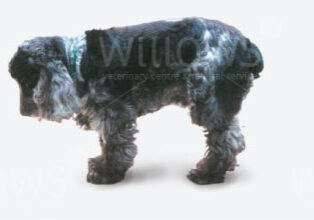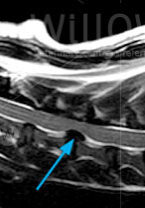Why Should I Bring my Pet to Willows for Cervical Disc Disease?
Willows is one of Europe’s leading small animal referral centres. Our state-of-the-art hospital is led by internationally renowned Specialists, committed to providing the highest standards of veterinary care. Our team of Specialist Neurosurgeons have extensive experience, having treated thousands of dogs with cervical slipped discs, providing gold standard management and treatment for all our patients.
Our Neurosurgeons are supported by our multi-disciplinary team of Specialists across several disciplines including; Anaesthesia, Diagnostic Imaging and Emergency and Critical Care. Willows also has a large dedicated team of Vets, Nurses and clinical support staff available 24 hours a day, every day of the year to provide the best possible care for your pet.
What is Cervical Disc Disease?
A more common term for cervical disc disease is a ‘slipped disc’ in the neck. The discs are the structures between the bones of the spine (vertebrae) that act as shock absorbers.
Why are the Causes of Cervical Disc Slip?
As in people, discs in dogs degenerate as they get older. This process results in the discs becoming dehydrated and losing their cushioning effect. They may then ‘slip’ in one of two ways.

What are the Signs of a Cervical Slipped Disc?
Signs of cervical disc disease are due to either:
Neck pain: Signs of neck pain may be obvious e.g. yelping and crying or rigidity of the neck. More subtle signs include reluctance to jump or climb and low head carriage. Difficulty lowering the head to eat from the floor may also be evident.
Nerve injury: Signs of nerve injury are uncommon with cervical disc disease. Occasionally discs that ‘slip’ in the neck can sufficiently compress the spinal cord to cause weakness or lack of co-ordination of all four limbs.
Fig 1: Cocker Spaniel showing low head carriage due to cervical disc disease


How is Cervical Disc Disease Diagnosed?
A neurological examination is necessary to detect evidence of spinal cord injury and neck pain. Following the examination investigations are necessary to confirm a ‘slipped disc’ and exclude these other possible conditions.
X-rays of the neck may reveal evidence of cervical disc disease, such as a narrowed disc space or a calcified disc. However, more advanced investigations are necessary to see which disc has actually slipped and to assess the severity of any spinal cord compression. These advanced imaging techniques, include the use of radiography or CT after injecting a dye (contrast agent) around the spinal cord (myelography or CT-myelography respectively) or an MRI scan.
MRI is less invasive than myelography with less risk of side-effects, for most patients MRI provides the best option for investigation. Both MRI and myelography require the dog to have a general anaesthetic. Occasionally it is necessary to collect some fluid (cerebrospinal fluid – CSF) from the spine and send it to a laboratory for analysis. This test assists in the diagnosis of inflammatory conditions that affect the spine.
Fig 2: MRI scan showing a slipped disc in the neck
What Treatments are Available for Cervical Disc Disease?
The two main methods of managing cervical disc disease are:
Conservative treatment: In dogs with cervical disc disease that are undergoing conservative treatment their exercise must be restricted. Short walks on a harness for toileting purposes may be necessary, with strict confinement at other times. The hope is that the ‘slipped disc’ will heal, any neck pain subside and the spinal cord recover from any injury. Painkillers may be necessary and possibly other drugs such as muscle relaxants.
Surgery: Surgery aims to remove any disc material that is compressing the spinal cord and to prevent any more disc material ‘slipping’. Decompressive surgery involves removing a section of bone from the bottom of the spine (ventral slot) to enable retrieval of disc material. Further ‘slipping’ is prevented by removing any remaining material in the centre of the disc (disc fenestration). Occasionally vertebral stabilisation (fusion) procedures are necessary, especially in large dogs.
What can I expect if my pet is treated for Cervical Disc Disease?
The outlook or prognosis with cervical disc disease is generally good. Conservative management can be successful in patients with neck pain who don’t show signs of spinal cord injury, such as weakness and incoordination. Unfortunately, some dogs continue to deteriorate with this approach or recover only to have a recurrence weeks or months later.
The success rate with surgery is generally high provided that the spinal cord hasn’t been compressed for a long time (chronic spinal cord injury). Chronic cord injuries can be treated successfully with surgery, but the outlook is less favourable than it is for short-term (acute) injuries.
To save this page as a PDF, click the button and make sure “Save as PDF” is selected.
Neurology
Find out more
To assist owners in understanding more about Neurological conditions, investigations and treatment we have put together a range of information sheets to talk you through the some of the more common neurological conditions seen by our Specialists.

